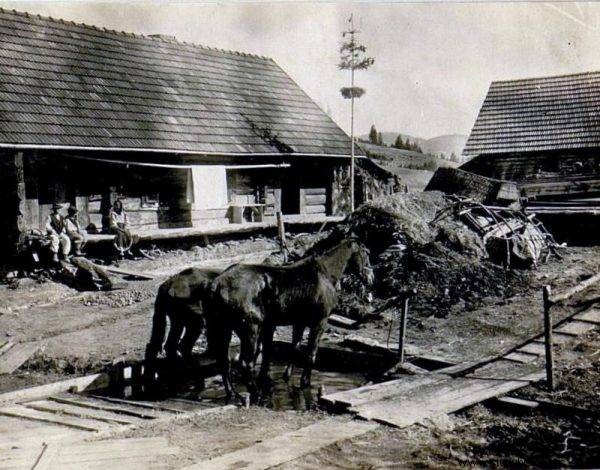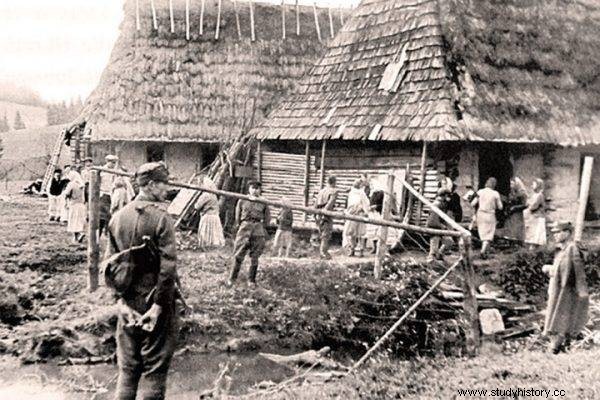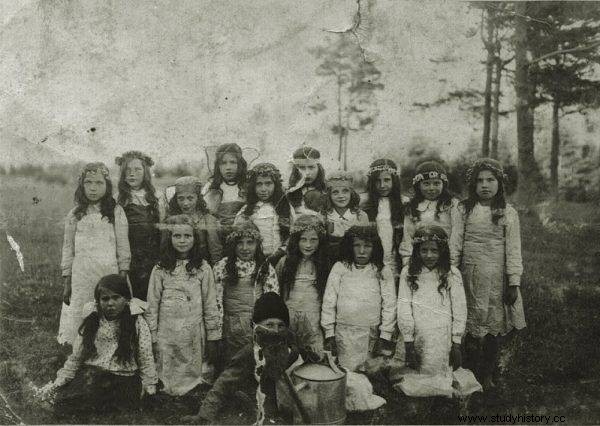They fell victim to two forced evictions, including the infamous Operation Vistula. However, they survived those years and the difficult times of the People's Republic of Poland. Who exactly are the Lemkos?
Where did this ethnic group come from? It is difficult to say unequivocally. Various theories can be found about this. According to one of them, the Lemkos would come from the Wallachians who came from Romania colonizers who reached the areas of Bieszczady, Beskid Niski and Sądecki. Another theory is that the Lemko lands were in the past inhabited by the so-called Bialochorvat tribe . Finally, there are voices that the Lemkos come from the nomadic lifestyle of Thracian shepherds .
Another interesting issue is the very origin of the name "Lemkos" . It is quite surprising, because its authors are not interested themselves, but their neighbors, Boyko. This was the term used by the Ruthenians who, according to them, abused the expression "łem", meaning "but, only, only" . It was originally just a nickname. Only later did it begin to take the form of an "name" of an ethnic group, displacing expressions such as Ruthenians.
Difficult and long story
The history of the Lemkos is longer than we might think. Lemko literature appeared in the 16th century . According to some historians, the beginnings of the processes that resulted in the establishment of the Lemko ethnographic group could be found even in the 14th century. It was then that Wallachian-Ruthenian shepherds reached the Carpathians.

The Lemko region covers the area of the Central Carpathians.
Traditionally, until the outbreak of World War II, Lemkos lived in the area known as the Lemkos region. They themselves refer to it as Lemkowyna . This area stretches across the Middle Carpathians - from the Osława valley in the east to Poprad in the west. Most of the Lemkos lived in the Low Beskids and the Sądecki Beskids. Currently, some Lemkos define themselves as a separate ethnic group, which places them in the ethnic circle of the so-called Carpathian or Carpathian Rusyn .
After Poland regained independence, the Lemkos were protected, among others by the provisions of the so-called the small treaty of Versailles, i.e. the Treaty between the main allied and associated powers and Poland, signed at Versailles on June 28, 1919 At the end of World War II and right after it two large-scale resettlement actions turned out to be tragic for the Lemko community .
Forced Resettlement
The first one was carried out in the years 1944–1946. It was the result of an agreement concluded between the Polish Committee of National Liberation and the Ukrainian Soviet Socialist Republic . It concerned the exchange of people living in the border area. The Lemkos themselves were not mentioned in it, so they felt safe. Despite this, the resettlement also affected them. They were supposed to go to Ukraine, although most of them felt Poles . Due to unsatisfactory results at the "voluntary" stage, a special operational group "Rzeszów" was included in the action, which dealt with forced removal.

The Lemkos fell victim to forced resettlement during the operation "Vistula".
Those Lemkos who did not leave Poland were to move west. It happened mainly during the action "Vistula", carried out in 1947. It was considered necessary to carry out a vigorous action to resettle these people in the spring [mainly Ukrainians who, according to the authorities of the time, were to form the basis for the formation of, among others, band UPA] single families scattered throughout the Recovered Territories, where they will quickly assimilate . The mysterious death of general Karol Świerczewski became the immediate pretext for the operation.
People were only given 2-3 hours to prepare for their departure. Lemkos from the Lemko region and the Lublin region went mainly to the northwest of Poland , to lands completely foreign to each other. They were also forcibly dispersed, because it was decided that in a given town it was not allowed to place more than 10% of the population displaced during the implementation of the "Vistula" . The result was the progressive disintegration of the community, which began to hide from its culture. Oil was added to the fire by propaganda that portrayed them as displaced "as a punishment".
Ethnic minority
And in such a difficult reality the Lemkos had to function then. At first, they integrated partly within the Board of the Provincial Board of the Ukrainian Social and Cultural Society (UTSK) However, the desire to support the Lemko culture and the postulates to return to their homeland caused opposition from the Polish United Workers' Party, which described it as anti-Soviet activity, and from the Main Board, which resolved the inconvenient Provincial Board. Later, various grassroots initiatives were undertaken, such as the establishment of the Provisional National Organizing Committee of Lemkos and Ruthenians in Poland on May 25, 1958. However, such initiatives were not accepted by the Polish authorities, and the Main Board of the UTSK even described it as separatist activity. Nevertheless, the Lemkos tried to create their own cultural organizations.

Lemko children in 1938
Their situation did not change until the turn of the 1980s and 1990s. On April 7, 1989, the Law on Associations was adopted. The Lemko Association (1989) and the Lemko Union (1990) were registered. Cultural and educational activities began to develop. In the context of the latter, the teaching of the Lemko language, which belongs to the group of East Slavic languages, was extremely important. Its introduction to primary education was announced at the 1st Congress of the Lemkos Association at the end of 1990. Lemko language teaching points began to appear. In the 21st century, their number exceeded 20. The National Enlightenment Commission was established at the Main Board of the Association, the initiative of which became a stimulus to start work on a dictionary of the Lemko language at the Institute of East Slavonic Philology of the Jagiellonian University. It should also be emphasized that in 2001 at the Pedagogical Academy (now the Pedagogical University) in Krakow started the Russian philology course with the Ruthenian-Lemko language, after which you have the opportunity to start teaching.
Most importantly, however, the Lemkos were able to start returning to the areas inhabited in the past. And by virtue of the Act of January 6, 2005 on National and Ethnic Minorities and Regional Language, the Lemkos became, along with Karaims, Roma and Tatars, one of the recognized ethnic groups in Poland. According to the results of the 2011 census, 9,641 Polish citizens declared their membership in this group. Most of them lived in the area of Beskid Niski and Beskid Sądecki. Several Lemko magazines are published in our country, such as "Besida", "Watra" and "Łemkowski Rocznik". In the cultural context, it is worth mentioning that the famous Nikifor Krynicki, or Epifaniusz Drowniak, was Lemko. Lemkos in Poland belong to the Catholic Church of the Byzantine-Ukrainian Rite and the Polish Autocephalous Orthodox Church. Traditionally, Lemkos have always shown attachment to the Eastern Church. One of the still existing evidence of this are the Lemko Orthodox churches located in the Silesian Beskids and the Low Beskids.
Bibliography
- Dudra, Lemko "becoming" a nation , "Przegląd Narodnościowy", No. 2/2013.
- Lemkos , www.gov.pl (access:February 25, 2022).
- Misiak, Lemkos - only "others" or even "strangers"? , "Acta Universitatis Wratislaviensis. Language education ", No. 16/2018.
- A. Orłowska, Polak - Lemek, two nephews (about life in a multicultural society - then and now) , "Borderland. Social Studies ”, vol. XVII / 2011.
- Szarota, Lemkos. Reconstruction of ethnic identity [in:] Z. Szarota (ed.), Adult education towards disadvantaged individuals and groups:towards social unity , Scientific Publishers of the Pedagogical University, Krakow 2012.
